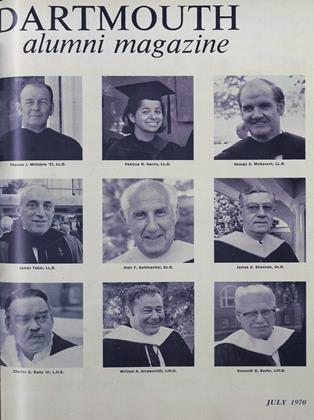ByEugene Vance '57. Englewood Cliffs,N.J.: Prentice-Hall, Inc., 1970. 118 pp.$4.95.
Since its discovery and publication by Francisque Michel in 1830, the Oxford version of the Chanson de Roland has been the subject of more scholarly books and articles than almost any other single medieval French narrative poem. The great majority of these studies are highly technical in nature, dealing either with the question of the origins of the medieval epic - the Oxford version of the Roland lends itself to this controversy since it is the oldest extant French epic - or with internal problems posed by the Roland itself. Only recently, have we had several introductions to the Chanson de Roland aimed at the general reader, and none of them in English.
Eugene Vance's Reading the Song ofRoland is thus a long overdue guide to this important and seminal work for English and American readers. In as much as all the quotations are imaginatively translated, even those who cannot read French will be able to follow Vance's exposition.
Professor Vance has wisely chosen to stick closely to the poem itself, leaving the scholarly arguments, which he mentions when absolutely necessary for the clarity of his own interpretation, to the kind of scholarly works mentioned in the section entitled "Further Reading." The organization of the book is naturally dictated by the pedagogical purpose it seeks to fulfill. Thus the first four chapters deal with problems which the medieval epic poses for the reader unfamiliar with the special language, warrior society, and poetic conventions of the genre. Once these aspects have been clearly and lucidly explained, Professor Vance moves on to consider the four main parts of the narrative. Of necessity, there are statements, based upon Professor Vance's own critical perspective, to which the specialist will take exception. Such passages are rare, however, and in no way compromise the book's utility for the general audience. This utility is definitely enhanced by the map showing the location of the sites mentioned in the poem, the chronology of events, and the various historical and critical aids included in the four appendices. Professor Vance has written a much-needed book that anyone interested in medieval literature may read with pleasure.
Mr. Nichols is Professor of Romance Languages and Literatures at the College.
 View Full Issue
View Full Issue
More From This Issue
-
 Feature
FeatureHYBRIS AND SOPHROSYNE
July 1970 By WILLIAM AYRES ARROW SMITH, LITT.D. '70 -
 Feature
FeatureDartmouth Undying
July 1970 By SHERMAN ADAMS '20 -
 Feature
FeatureDero A. Saunders '35 Elected President of Alumni Council
July 1970 -
 Feature
FeatureHONORARY DEGREE CITATIONS
July 1970 -
 Feature
FeatureReunions, 1970 Style
July 1970 By JAMES L. FARLEY '42 -
 Feature
FeatureFour Alumni Awards
July 1970
STEPHEN G. NICHOLS JR. '58
Books
-
 Books
BooksSHADOWS ON THE LAND — AN ECONOMIC GEOGRAPHY OF THE PHIL IPPINES.
MAY 1964 By ALBERT S. CARLSON -
 Books
BooksMan and his Fellows: Lectures on the Henry LaBarre Jayne Foundation, Academy of Music, Philadelphia, 1925
May, 1926 By C. D. Adams -
 Books
BooksNORTHWEST TO FORTUNE.
JANUARY 1959 By JOHN HURD '21 -
 Books
BooksStories With Purpose
SEPTEMBER | OCTOBER 2020 By JOSEPH BABCOCK '08 -
 Books
BooksSeparate, Unequal
April 1981 By Kenneth Libo '59 -
 Books
BooksTHE CHILD'S WORLD IN STORYSERMONS
November 1938 By Roy B. Chamberlin




